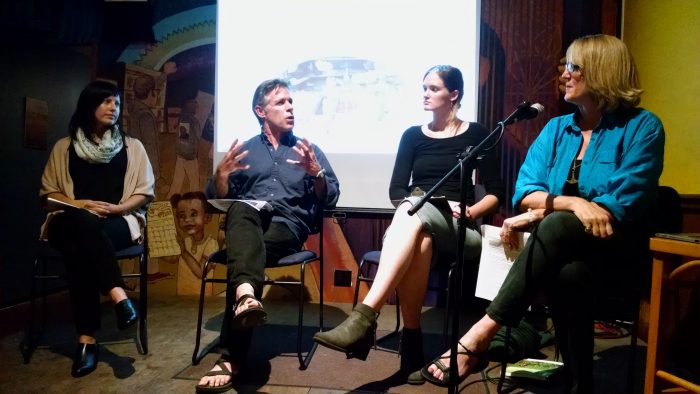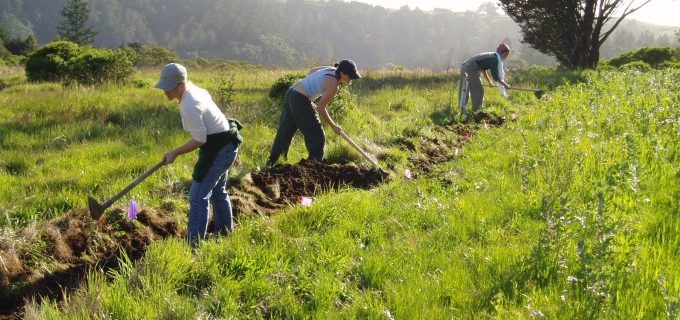The Move to Agroecology: Incremental or Radical Change?
On Wednesday, August 17th Food First’s Eric Holt Giménez moderated the monthly panel event at La Peña Cultural Center, which provides a collaborative space between community members, activists, and researchers to explore the challenges and transformations of our global food system. This month’s event focused on agroecology and the structural obstacles and opportunities for enabling agroecological systems, sparking lively debate with many contributions from the audience.
Panelists included:
Kendra Klein, PhD, is staff scientist at the Friends of the Earth, where she leads agro-ecology and farming solutions work. Kendra has fourteen years’ experience as writer, researcher and advocate in environmental sustainability, food and agriculture and environmental health, and has written for civil advocacy networks as well as multiple peer-reviewed academic journals.
Ahna Kruzic is from rural southern Iowa and holds a Master of Science degree in Sustainable Agriculture and Sociology, researching identity construction and whiteness and racism in alternative agriculture movements. Now Food First staff, Ahna coordinates and contributes to Food First’s communications and research-for-action, which seeks to dismantle exploitative racism, capitalism and oppression in the food system.
Kristin Schafer has worked as a communication specialist for the US EPA at the World Resources Institute’s Sustainable Agriculture program and an agro-forestry extension officer with the Peace Corps and Kenya, before coming into her current position at the Pesticide Action Network (PAN). At PAN, Kristin works on issues around toxic chemicals in the food production and food supply.
Eric opened the discussion by first distinguishing between agroecology as a scientific discipline, as a practice, and as a political movement. Agroecology as a scientific discipline is the careful observation of agroecological practice. While agroecology as a scientific disicipline increasingly validates agroecology, the fact that the vast majority of land is not in agroecological production necessitates a political approach:
‘’Modern agriculture is destroying not just agro-biodiversity and environment, but the cultural fabric of agriculture. That is why we see a desire and a move to re-establish agro-ecological systems. And that is a deeply political act, because it runs counter to the system we have, counter to all the rules and the institutions and regulations and the incentives, for profit and the monopolies, it really is quite a revolutionary act.’’
 Therefore, the panel set out to explore the question “If agro-ecology is so great, why aren’t more farmers doing it?” In other words, what’s holding it back? Further, how can agro-ecology help us transform capitalism itself?
Therefore, the panel set out to explore the question “If agro-ecology is so great, why aren’t more farmers doing it?” In other words, what’s holding it back? Further, how can agro-ecology help us transform capitalism itself?
Stay in the loop with Food First!
Get our independent analysis, research, and other publications you care about to your inbox for free!
Sign up today!Contextualizing these questions, Ahna pointed out the lack of agroecological practice can largely be traced back to ways in which agroecological systems are incompatible with capitalist structures of production, requiring in-depth, place-based knowledge and ample labor. While agroecological systems produce ample food and jobs, they cannot scale up in the way industrial systems can, and cannot produce capital in the way an industrial system does. Farmers in the US are caught in a system in which subsidies cover the problem of perpetual overproduction, driving low prices:
‘’I want to emphasize farmers aren’t to blame. A lot of the farmers I know back home don’t want to be producing monocultures of corn, and would tell you: ’I really wish I could grow carrots, but I’ve got to feed my family’. This is the irony of the system we are in, farmers aren’t feeding family with food, but capital’’.
Building on this, Kirstin shared some of her research, showing how increasing inputs ensures dependence on and accrual of wealth withinin seed and chemical companies, driving agrochemical corporate consolidation and concentration of power in the food system.
Scaling up agroecology is particularly difficult when the associated forms of production conflict with the incentive and legal structures of the dominant system.
Such conflict, however, Kendra argued, can bring opportunities for pragmatic solutions. In her work supporting local food sourcing for hospital meals, she experienced how conflicting norms of economic efficiency and the moral imperative of a hospital to human and environmental health can highlight values and inconsistencies that can otherwise remain invisible, ultimately leveraging gradual changes.
While the considerations for such solutions are context-dependent, voices from the audience warned that adopting a too-pragmatic approach risks accommodating to the mandates of conventional agriculture. For instance, one person argued:
“The idea that we need to scale up, the idea that we need to grow bigger – to grow more – is not how we need to deal with this. Accessibility should be what we are looking at. The idea that we, as human beings, should keep these corporations afloat is not what we need to be reaching for.’’
Taking this point further, another person proclaimed:
“Energy should be going to working at food sovereignty at the local level in every community. If we all do that, then focus on the capitalist system, at least in terms of food, will have its own death.’’
In response, Miguel Altieri spoke from the audience, emphasizing that agroecology was born and developed as a practice in Latin America, where it became known as a science and political movement, and picked up as alternative approach to industrial ag in the global north relatively recently:
“There is a huge mismatch, because the origins of agro-ecology were in a the different ecological, social and political context, and when you try to bring it here, what happens is it is immediately subordinated to capitalism.’’
Maywa Montenegro elaborated on Miguel’s contribution, noting what’s holding back agroecology is not just an incompatibility of physical economic structures, but the underlying views through which agricultural systems have developed:
“I think, one thing that is holding back agroecology is buried in the liberal creed that we need to strive for individual private property…When we think of how we can break out of that modality, that I need to own the seed or this piece of land in order to have use-value out of it, to feed my family, to feed my community, is a deep, moral epistemic issue. I am interested in how we can break out of that since it is so embedded in US history and politics and culture.”
Continuing, another audience member, Matt Nosco, raised the question that given the difference between agroecological systems and conventional systems, how can we understand the role of corporate influence on media and research and the political position agroecology is able to carve out for itself?
In response, Kristin noted that currently, ongoing agrochemical corporate consolidation further intensifies corporate control over public debates on agricultural systems. At the same time, Kendra added, only 5% of US-based agricultural funding goes to anything remotely related to agroecology, showing clear inequalities in agricultural research. Accordingly, the reality of agroecological research, as Ahna observed, is shaped by an interplay of multiple factors:
“The question of who is funding what questions we get to ask in the first place goes beyond the physical dollars of funding; it is culture of silence and a culture of fear in talking about agroecology. When it is talked about, agroecology is often talked about in a way that it is apoliticized; you can talk about the biophysical science behind it, but you can’t talk about the social and political implications. That is not what is valued, and that is certainly not what gets you tenure.”
While agroecology is increasingly adopted into mainstream structures of research and agricultural development programs, it is rarely credited as a radical approach to change the food, agricultural, or sociopolitical system. Miguel argued that what is left of agroecology as political behest is both neutralized or counteracted through its appropriation by multilateral institutions and private actors:
“Agroecology is talked about as just another tool in the toolbox to solve the problems of industrial agriculture, which can be combined with transgenics and climate smart agriculture. Now we really need to clarify what we are talking about. Are we talking about an alternative to capitalism, or are we talking about agroecology as one more tool that can be tweaked to fit the capitalist system?”
In parallel to the necessity of keeping the political nature of agroecology at the forefront, Eric pointed to a central issue underlying food advocacy and food system analysis work:
“I think there is not a good dialogue between the people who are dealing with the very immediate issues of survival and safety and health, and many of us who are dealing with the big structural issues. I always go back to the Black Panters on this, who talked about survival pending revolution. This hasn’t changed. I think most communities in the world are dealing with survival, trying to access healthy food in their communities, which are riven by all sorts of problems. We can’t solve the problem of food without addressing the other problems. My question is, can agro-ecology help bridge, what I feel is sometimes a gulf, between solving the big structural questions of capitalism and the planet and the immediate issue of survival?”
Kirstin offered insight, pointing out that an understanding of agroecology is coupled with an understanding of livelihoods, because an understanding of livelihoods is intricately built into agroecological farming systems – agroecology by nature enables access to food and environmental justice. She also noted that many underserved communities are farmers and people living in rural communities:
“We hear stories from farmers who have to drive two hours to get fresh produce because they are surrounded by fields of non-food. If you have policies in place that enable farmers to diversify, you are going to go a long way towards addressing food access.”
Bridging structural and immediate questions of survival, Kendra argued, requires understanding the farm as situated within both natural and economic systems, enabling people to understand the deeper connections between themselves, their community and the environment.
Further, Ahna argued to account for the means in which agroecological practices manifest politically through different levels of food systems:
“Agroecology as either practice, science, or political movement will not create social and political transformation, but these three in tandem form the platform from which agroecology can transform capitalism. Practices of agroecology require a lot more labor and place-specific knowledge, through which we develop social and political relations. Agroecological systems increase our social and political capital, which can provide opportunity for systemic change.”
Kristin concluded by noting that a public shift in the ways in which people participate in food systems change is indeed happening:
“What is hopeful to me is that people in the food movement are contributing to that shift, where people are actually starting to think of themselves less as consumers and more as engaged citizens. This is a political issue, and by recognizing that, taking control of local councils and making these issues a political priority there are some real shifts, that can enable the kind of policy changes that we are going to need in the long term, to get the kind of support for agro-ecological farming that is meaningful.”
Featured agroecology photo by Roman Alcantara.


 Help Food First to continue growing an informed, transformative, and flourishing food movement.
Help Food First to continue growing an informed, transformative, and flourishing food movement.




